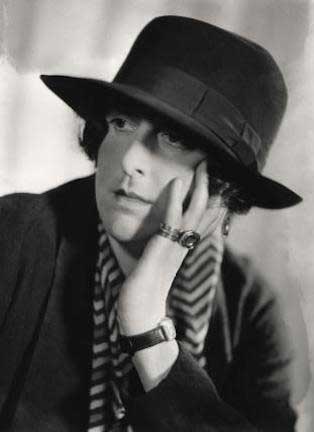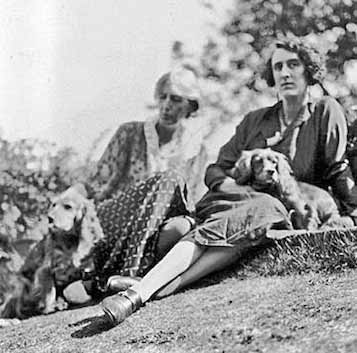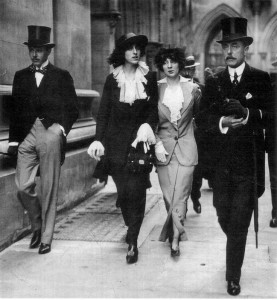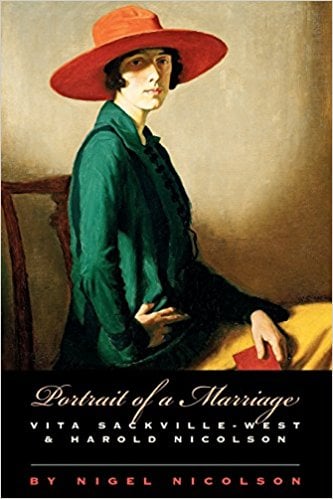Vita Sackville-West, British Novelist and Poet
By Nava Atlas | On June 15, 2018 | Updated August 24, 2022 | Comments (0)

Vita Sackville-West (March 9, 1892 – June 2, 1962), was a British poet, novelist, and garden designer. Born at Knole Park, a 365-room ancestral home, her writing career was launched with the publication of Poems of East and West (1917).
She’s known for her private life and as a master gardener perhaps as much as her literature. She was bisexual and concurrent with her happy marriage with Harold Nicolson (also bisexual) had many affairs with women.
It’s widely believed that Vita was the inspiration for the title character of Virginia Woolf’s novel, Orlando.
Vita was part of the literary Bloomsbury circle, which included Woolf and her husband, Leonard, as well as E.M. Forster, Lytton Strachey, John Maynard Keynes, and others.
Vita was a productive writer, practicing in several genres — fiction and memoir chief among them. She was a prolific poet as well. She often seems best remembered best for her brief love affair with Virginia Woolf, which is a pity. According to a 2020 article in Paris Reviews, “The Fabulous Forgotten Life of Vita Sackville-West”:
“How preposterous is it that Vita Sackville-West, the best-selling bisexual baroness who wrote over thirty-five books that made an ingenious mockery of twenties societal norms, should be remembered today merely as a smoocher of Virginia Woolf?
The reductive canonization of her affair with Woolf has elbowed out a more luxurious, strange story: Vita loved several women with exceptional ardor; simultaneously adored her also-bisexual husband, Harold; ultimately came to prefer the company of flora over fauna of any gender; and committed herself to a life of prolific creation (written and planted) that redefined passion itself.
Early life at Knole
Vita Sackville-West grew up at Knole in Kent, the famous “calendar house” with its 365 rooms, 52 staircases, 12 entrances, and 7 courtyards. It’s now in the care of the National Trust in Britain. Born to Lionel Sackville-West and his Spanish wife, Victoria, (his first cousin and the daughter of his uncle’s mistress), the couple split when Vita was young.
She was educated at home during her early childhood, and later attended, Helen Wolff’s school for girls. Not one to befriend her peers easily, her biographies paint her childhood as lonely. While attending the school for girls, Vita met Violet Keppel and Rosamund Grosvenor, with whom she’d later conduct intimate affairs.
Vita’s mother, Victoria, was courted by many men, most notably financier J.P. Morgan and Sir John Murray Scott. Vita spent a great deal of time with the latter during her childhood at his home in Paris, perfecting her French. Vita’s father, Lionel, had a relationship with an opera singer, moving her into Knole.
The Sackville family inheritance custom disallowed for females to inherit the estate, and as the only child born to her parents, Knole was bequeathed to her father’s younger brother, the fourth Baron Sackville.
Vita had written prolifically at Knole, penning eight novels (unpublished), ballads, and plays while living there. The loss of Knole haunted Vita, especially in 1947 when signing the property over to the National Trust.
She wrote that “the signing… nearly broke my heart, putting my signature to what I regarded as a betrayal of all the tradition of my ancestors and the house I loved.”
. . . . . . . . . .

Quotes by Vita Sackville-West
. . . . . . . . . .
Open marriage to Harold Nicolson
One of the most notable of Vita’s affairs was with childhood friend Violet Keppel, which began before Vita’s marriage to Harold. By the age of sixteen, Vita and Violet had developed a strong emotional bond, and by their twenties were romantically involved. The relationship continued through Vita’s eventual marriage in 1913.
At age 21, Vita married Harold George Nicolson, a wealthy writer, politician, and diplomat who was also bisexual. The couple engaged in an open marriage, courting many same-sex affairs, fashioning a relationship structure ahead of its time.
The couple had two sons, Nigel and Benedict. Nigel would later combine his mother’s diaries with his own observations in Portrait of a Marriage, the confessional autobiography Vita had written during her relationship with Violet Keppel. In it, he wrote:
“Sir Harold, distinguished writer, scholar, diplomat, and statesman, was a social, extroverted being; Vita, a poet and novelist, was the product of mingled Spanish and English blood, once described as “romantic, secret, and undomesticated.”
They both thought marriage ‘unnatural,’ but realized that, as a happy marriage is ‘the greatest of human benefits,’ husband and wife must strive hard for its success. Each must be supple enough, subtle enough, to mould their characters and behaviour to fit the other’s facet to facet, convex to concave.’
Which is precisely what they managed, achieving in time ‘the strangest and most successful union that two gifted people have ever enjoyed.'”
. . . . . . . . . .

. . . . . . . . . .
Involvement with Virginia Woolf
Later, Vita would become deeply infatuated with Virginia Woolf. The connection began in 1922, when Virginia Woolf was forty years old, ten years Vita’s senior. Upon meeting, Vita was instantly attracted. After meeting Woolf, she wrote in a letter to Harold dated in December 1922:
“I simply adore Virginia Woolf, and so would you. You would fall quite flat before her charm and personality… Mrs. Woolf is so simple: she does give the impression of something big. She is utterly unaffected: there are no outward adornments — she dresses quite atrociously.
At first you think she is plain, then a sort of spiritual beauty imposes itself on you, and you find a fascination in watching her. She was smarter last night, that is to say, the woolen orange stockings were replaced by yellow silk ones, but she still wore the pumps.
She is both detached and human, silent till she wants to say something, and then says it supremely well. I’ve rarely taken such a fancy to anyone, and I think she likes me. At least, she asked me to Richmond where she lives. Darling, I have quite lost my heart.”
Vita purportedly became Virginia’s lover and muse, inspiring the groundbreaking 1928 novel Orlando, though the defining characteristic of their connection was deep friendship.
. . . . . . . . . .
Portrait of a Marriage: Vita Sackville-West and Harold Nicolson
. . . . . . . . . .
Career and legacy of Vita Sackville-West
Vita chose the Hogarth Press (the publishing house run by Virginia Woolf and her husband, Leonard) to be her publisher for Seducers in Ecuador in 1924. The novel wasn’t as successful as she’d hoped, selling just 1,500 copies in its first year.
The Edwardians, her second novel published with Hogarth Press in 1930, on the other hand, was a huge success. It sold 30,000 copies in its first six months, arguably remaining one of her best-known works. In 1932, Vita published Family History, boldly tackling the subject of lesbianism.
Vita focused mainly on fiction and also parlayed her passion for gardening into many essays and columns on the subject. In 1947, Vita was made a Fellow of the Royal Society of Literature and Companion of Honour. Her distinguished body of work includes twelve poetry collections, seventeen novels, and nine works of non-fiction and biographies.
Mary Ann Caws, editor of Vita Sackville-West: Selected Writings (2002) summed up her legacy:
“In a sense, Vita Sackville-West personified the best and most valorous part of what the Bloomsbury culture has come to mean to us: an undending enthusiasm for creation and life and a nonchalance in regard to what a generally normative society believes one’s behavior should be and represent.
Vita did exactly as she pleased, worked double-time at her poetry and her other writing, as well as her gardening, she traveled immensely and with resourcefulness and knowledge, and excelled in multiple genres she encompassed as fearlessly in her writing as in her living.
Overall, and most crucial to her reception as author and person, I believe that her essential quality was her great and lasting courage: in the vast range of things she did, the people she loved and was loved by, and in her intensity of living, in which she never failed.”
Vita died at Sissinghurst at age seventy from abdominal cancer. She was cremated and her ashes buried in the family crypt in eastern Sussex.
Her son Nigel lived at Sissinghurst after her death, and after his own passing in 2004, his son moved in with his family. The gardens Vita and Harold designed at Sissinghurst Castle are still visited and admired today.
. . . . . . . . . .

Harold Nicolson,Vita Sackville-West,
Rosamund Grosvenor & Lionel Sackville-West, 1913
More about Vita Sackville-West
On this site
- Beyond the Legend: Virginia Woolf & Vita Sackville-West’s Love Affair and Friendship
- Quotes by Vita Sackville-West
- Quotes on Gardens and Gardening
- Dear Literary Ladies: Is it better to be a modest success than to risk failure?
Major Works – Novels
- Heritage (1919)
- The Dragon in Shallow Waters (1921)
- The Heir (1922)
- Challenge (1923)
- Grey Wethers (1923)
- Seducers in Ecuador (1924)
- Passenger to Teheran (1926)
- The Edwardians (1930)
- All Passion Spent (1931)
- The Death of Noble Godavary and Gottfried Künstler (1932)
- Thirty Clocks Strike the Hour (1932 – short stories)
- Family History (1932)
- The Dark Island (1934)
- Grand Canyon (1942)
- Devil at Westease (1947)
- The Easter Party (1953)
- No Signposts in the Sea (1961)
Poetry collections
- Chatterton (1909)
- A Dancing Elf (1912)
- Constantinople: Eight Poems (1915)
- Poems of West and East (1917)
- Orchard and Vineyard (1921)
- The Land (1926)
- King’s Daughter (1929)
- Sissinghurst (1931)
- Invitation to Cast out Care (1931)
- Collected Poems: Volume 1 (1933)
- Solitude (1938)
- The Garden (1946)
Letters
- Violet to Vita: The Letters of Violet Trefusis to Vita Sackville-West, 1910-1921
- The Letters of Vita Sackville-West and Virginia Woolf
Biographies
- Portrait of a Marriage: Vita Sackville-West and Harold Nicolson by Nigel Nicolson
- Vita: The Life of V. Sackville-West by Victoria Glendinning
More Information
- Wikipedia
- Reader discussion on Goodreads
- Garden Designer Vita Sackville-West
- The Fabulous Forgotten Life of Vita Sackville-West
Visit Vita Sackville-West’s homes

Leave a Reply